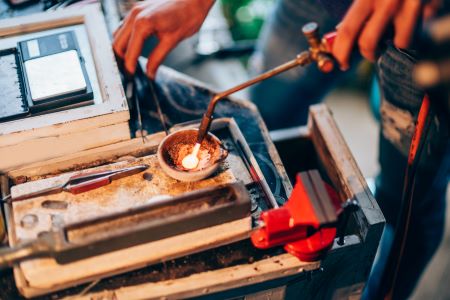Melting silver is an easy process once you get to know the fundamental principles of the metal’s melting points. Commonly used by many jewellers due to its lower melting point, silver is a great place to start when learning how to melt metal to make more complex jewellery designs, and graduate to more difficult soldering techniques.
Use our beginner’s guide on the art of melting silver below and don’t forget to download our complete beginners’ guide to working with silver for further tips and tricks, from cutting and sawing through to buffing and polishing.
The art of melting silver
It’s important to make yourself aware of the melting point of silver before you start working with it so that you use the right soldering equipment for the job. The best place to start is getting to know the melting point of silver…

What is the melting point of silver?
The melting point of silver will depend on which type of silver you’re working with. Remember that if you’re working with 925 sterling silver, this will have a lower melting point than 999 fine silver, simply due to its composition.
Use our table below to find out the melting points of the most commonly used types of silver:
| Types of Silver | Melting Point |
| 925 Sterling Silver | 890°C |
| Britannia Silver | 940°C |
| 999 Fine Silver | 961°C |
Different ways to work with silver
It’s worth noting that for the most part you won’t be completely melting pieces of silver sheet to create new pieces of jewellery. Instead you’ll be soldering small pieces of silver together or soldering findings to your metal. That’s why it’s a good idea to get a clear picture of some of the different technical terms associated with heating metal for soldering purposes. This will help you understand what signs to look out for when heating silver with a hand torch.
Here are just a few of those terms you’ll soon get to know throughout your silver heating process:
Annealing
This is when metal is heated to soften its structure. As silver is worked with, the particles of the metal become compacted, making it much less malleable and more difficult to work with. By annealing the silver (heating it until it glows a dull cherry red colour) you can relax the structure of the metal making it easier to work with once again.
Fire Stain
Fire stain is the oxidisation of the copper content found in sterling silver and occurs when the metal is heated. Fire stain is usually a faint dark shadow on the surface of the silver so can only be removed by repeated buffing. If the fire stain is not removed during buffing it will show up when you come to polish your piece.
Quenching
Quenching refers to the process of cooling your silver once it’s been heated. Once you’ve removed the piece of metal from the heat, it can then be quenched by simply dropping it into a bowl of water. Quenching usually follows a soldering or annealing process.
Soldering
Soldering is when two pieces of metal are joined together by using solder, flux and heating the metal with a hand torch. It’s essential to use solder because it has a lower melting temperature than the silver you’d be working with. That means that the solder will melt way before the piece of silver securing a finding or another piece to the existing piece without damaging it or causing it to melt along with the solder.
Silver Solder
Silver solder is used to create a bond between two pieces or ends of sterling silver. There are four different types of silver solder: hard, medium, easy, and extra easy. Each type of solder has a different melting temperature, so you can choose the appropriate solder for each stage in the soldering process. The idea is that each type of solder is to be used in sequence with the highest melting temperature used first (hard).
Now you know the basics of melting silver and the jargon that comes along with it, you’ll soon be ready to learn how to solder metal and create more intricate sterling silver pieces. For more information on soldering read our blog posts: A Guide To Simple Soldering and How To Silver Solder A Ring.
Our beginners’ guide to working with silver is aimed at those who are new to the world of metalsmithing. In this guide you’ll find all kinds of advice on working with silver from metal forming techniques right through to the final polish, so download our beginners’ guide to working with silver for free today.

Cooksongold

